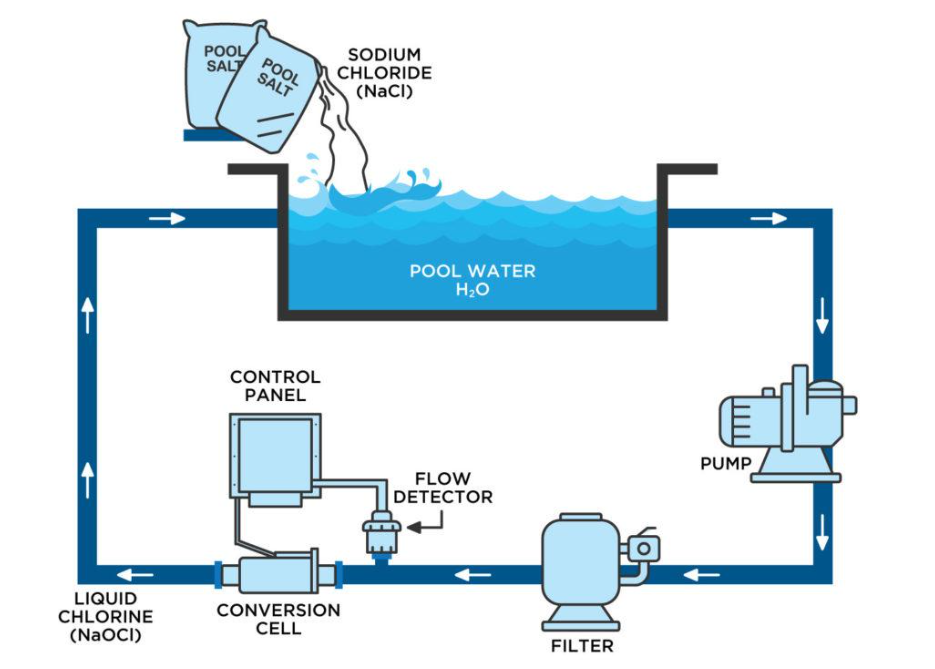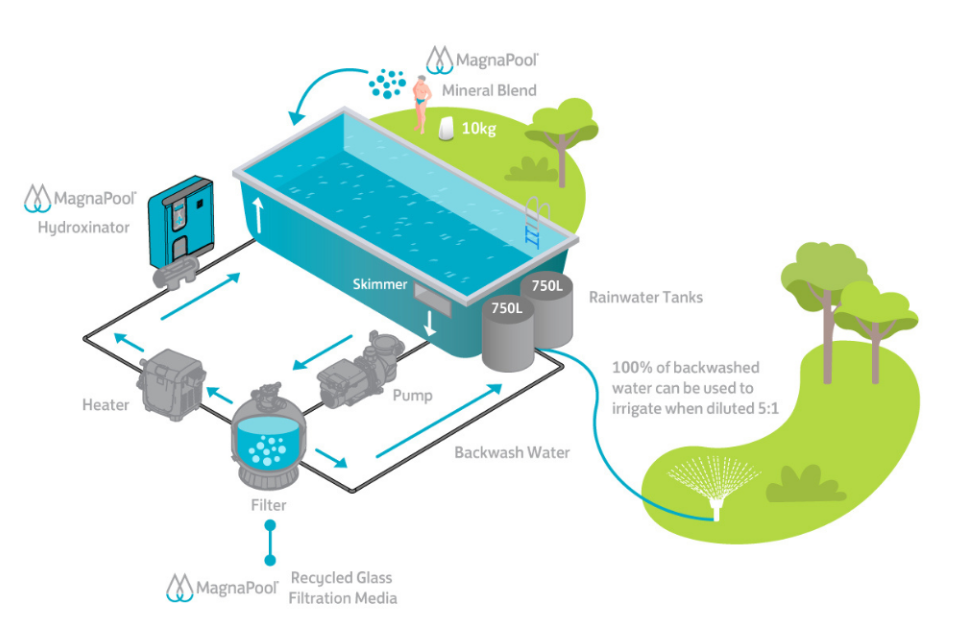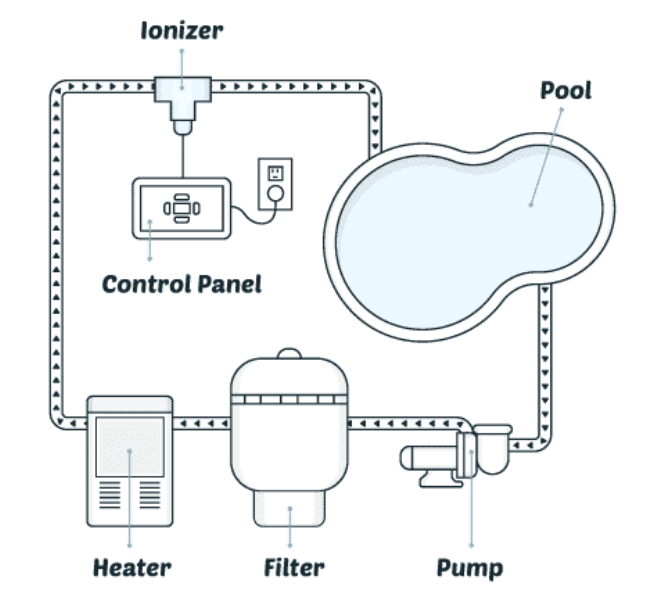4 Eco-Friendly Pools You Must Try
Making your pool eco-friendly isn’t always easy. It means running your pump for less time, turning off the heater or manually cleaning your pool. But this isn’t always practical, particularly when you’re tired or busy looking after your family.
Luckily, you can make your pool more sustainable – without sacrificing time or convenience – with an eco-friendly pool. Not only does it keep energy and water consumption to a minimum, but it can save you hundreds in running costs every year.
In this guide, we’ll introduce you to four eco-friendly pools that are trending at the moment – saltwater, mineral, freshwater and natural pools. We’ll explain what they do, how they reduce your carbon footprint and whether they’re the right choice for your pool. To finish, we provide some additional tips on making your existing pool – or new eco-pool – more sustainable. Let’s jump in!
What’s an eco-friendly pool?
As the word suggests, an eco-friendly pool is designed to have as little impact on the environment as possible. It does this by keeping energy and water consumption to a minimum, requiring fewer chemicals, and using renewable energy sources (e.g. solar energy). In many cases, the sanitation method used in these pools also minimises surface and equipment wear, keeping landfill and waste to a minimum.
Types of eco-friendly pools
There are many types of eco-friendly pools, but the main ones available in Australia are saltwater pools, mineral pools, freshwater pools and natural pools. Let’s take a close look to see how they work and what their pros and cons are.
1. Saltwater pool
Even though they’ve been around for a while, saltwater chlorination systems are a popular and effective way to reduce your pool’s carbon footprint. Unlike traditional pools, which use liquid or granular chlorine (whose manufacture can produce greenhouse gases), they use salt (sodium chloride) to sanitise your pool.
In simple terms, the salt circulates through your pool water, passes through the chlorinator and gets transformed into chlorine. Your chlorinator’s output then increases or decreases depending on your pool’s needs. This keeps your water balanced and reduces the need for chemicals or frequent cleaning.
Another advantage of saltwater systems is that the salt replenishes naturally in your pool. That’s because chlorine turns back into salt when it breaks down. This means you don’t need to keep topping up the salt levels to keep your pool sanitised. In fact, salt levels only need to be replenished after excessive splashing, dilution with rainwater, backwashing or evaporation.
Note: While the amount of salt used in salt chlorination systems is small, it can corrode your pool equipment. To avoid this, keep an eye on sodium levels and choose corrosion-resistant fittings.
Salt chlorinators also offer variable speed pump control. This means they adjust your pump’s speed according to your pool’s needs, reducing energy consumption. Some even have automation capabilities. For example, the eXO iQ Salt Chlorinator allows you to connect your pool cover and automatically drop your output, or even synch with your pool lights to control their use. For more information on how salt chlorinators work, see this article.
Pros
- No manual dosing of chlorine
- Fewer chemicals and pool cleaning required
- Salt is sustainable and gets replenished
- Can synch to your variable speed pump, pool cover and lights
Cons
- Can cause corrosion
- Salt chlorinator system.

Source: Leisure Pools
2. Mineral pool
Mineral pools are a popular alternative to chlorine pools. They use minerals like magnesium chloride, potassium chloride and sodium chlorine to keep your pool sanitised. Much like a saltwater chlorination system, the minerals pass through the chlorinator and get converted into chlorine. The output is then managed automatically, making manual chlorination obsolete. And like its salt counterpart, it can synch with a variable speed pump and automate with other equipment.
The biggest difference between a salt and mineral system is magnesium. This mineral is a natural flocculant that helps microparticles stick together, allowing them to be quickly removed by your filter. This keeps your pool cleaner and reduces the need for harsh chemicals and automatic cleaners. As a bonus, magnesium also provides therapeutic benefits for swimmers, such as easing sore muscles, relieving stress and soothing skin conditions.
The other advantage of mineral pools is that many (like MagnaPool) use recycled glass media. Glass has a charge that can attract and filter up to 5 microns of particles (sand can only filter about 20 microns). This improves filtration and keeps your pool cleaner without the need for clarifiers or flocculants. What’s more, you don’t need to backwash glass as often, or for as long, which can save up to 65 per cent of water compared to sand media.
Converting to a mineral system is also easy, particularly if you’ve already got a salt chlorinator. However, if you’ve got a chlorine pool, it may require new equipment, such as a chlorinator/hydroxinator and media filter, making setup expensive. For more information on mineral pools, see this article.
Pros
- No manual dosing of chlorine
- Fewer chemicals and pool cleaning required
- Synchs to your variable speed pump to reduce energy
- Glass media enhances filtration
- Magnesium reduces the need for flocculants
Cons
- Set-up costs can be high

MagnaPool mineral system. Source: MagnaPool
3. Freshwater pool
Sometimes known as ionised or chlorine-free pools, freshwater pools are becoming increasingly popular in Australia. While the name suggests that they’re chemical-free, they aren’t. With the help of an ioniser, they use copper and silver ions to sanitise your pool. The copper prevents the growth of algae and the silver kills bacteria. This technology isn’t new. Copper and silver have been used for centuries in water purification – and they’re still used by NASA to purify water in space!
But ionisers don’t work alone. First-generation ionisers struggled with large bather loads or big pools, so freshwater systems now use oxidisers as well (these are known as hybrid systems). This helps remove organic debris that copper and silver leave behind.
Like other eco-friendly pools, freshwater pools work with your variable speed pump to keep sanitation levels stable, eliminating the need for manual chlorination. What’s more, they work faster and run for half the time, minimising your energy expenditure.
Another advantage of this system is that copper and silver ions don’t degrade in UV light, unlike chlorine. This means you won’t need to stabilise it with cyanuric acid (CYA) or keep adding more sanitiser. In fact, you only need to replace your ioniser rods every few years, and the oxidiser cell every 5–7 years.
Finally, you can use the backwash from your freshwater pool in your garden. Unlike mineral or saltwater pool backwash, which needs to be diluted, the water from a freshwater pool contains no harsh chemicals, so it can nourish your soil and reduce water loss. What’s more, the ions won’t corrode your pool surface or equipment, unlike chlorine or saltwater pools.
Note: If your ioniser isn’t configured correctly, you may get copper staining in your pool. This can be removed with a metal stain remover or, as a preventative measure, use a metal sequestrant.
Pros
- No or minimal chlorine
- Runs for 50 per cent less time, reducing energy consumption
- Sanitiser won’t degrade in UV light
- Backwash can be used undiluted in your garden
- Doesn’t corrode your pool
Cons
- High set-up costs
- Non-hybrid systems may not be as effective in large or heavily used pools
- Need to replace rods and oxidiser

Pool ioniser. Source: Swim University
4. Natural pool
If you want a pool that looks like a natural body of water and eliminates chemicals altogether, consider investing in a natural pool. This system uses two pools or zones, one for swimming and one for aquatic plants (also known as the biozone or regeneration area).
Instead of using chlorine, a natural pool uses aquatic plants, such as lilies and reeds, to replicate the way plants clean ponds in nature. As a result, the water is light and refreshing, without the irritation many get from salt, chlorine or other chemicals normally found in pools.
To filter your pool, a pump moves the water between the two zones, allowing the plants to use biological processes to filter out bacteria and algae. And unlike traditional pool pumps, the unit is low-voltage, which means it works slowly and uses far less energy.
The only downside is that you may need a large garden to make a natural pool work. However, if you live in the suburbs and space is an issue, a biofilter can do a similar job. It uses the same friendly bacteria to clean and sanitise your pool without disrupting your landscaping.
While natural pools are the most expensive pool system to set up, running costs are lower than chlorine or saltwater pools. That’s because the pool pump is more energy-efficient, which can save you hundreds every year, and you won’t need to keep adding chemicals to balance the water. Plus, natural pools require less cleaning. Regular backwashes and the use of a low-wattage pool robot will remove debris and biofilm (friendly bacteria that make your pool slippery).
If you like your pool water warm, freshwater pools can also be heated up to 26 degrees Celsius without affecting the ecosystem. For best results, choose an energy-efficient heat pump, solar heater or solar pool cover.
Source: Pool Research
Pros
- No chemicals
- The water feels natural and refreshing
- Minimal energy consumption
- Requires less cleaning
Cons
- Expensive setup
- Needs a lot of space
Are eco-friendly pools safe?
All the pool sanitation systems mentioned in this article are safe, as long as you follow your manual for installation and maintenance. Plus, because most of these systems are self-regulating or automatic, sanitation levels remain within the correct range, keeping your pool free of harmful bacteria or algae. Not only is this safe for swimmers, but it’s also good for the health and longevity of your pool.
Can I make my chlorine pool more eco-friendly?
If you can’t afford an eco-friendly pool system just yet, don’t worry. Here are 14 ways you can reduce your chlorine pool’s energy and water consumption and make it more climate-friendly. Some of these tips have high setup costs, while others are free (see #8, #9, #12, #13 and #14). Either way, we recommend trying a few strategies at once. The more up implement, the more you save!
- Use a pool cover.
- Switch to a heat pump or solar heating.
- Upgrade to LED lights.
- Replace your single-speed pump with a variable-speed pump.
- Create a windbreak with trees or barriers.
- Use an automation system.
- Use a cartridge filter or glass media.
- Don’t drain your pool in winter.
- Don’t overheat your pool (keep it at 28 degrees Celsius).
- Harvest water from a water tank.
- Fix leaks to prevent water loss.
- Turn off water features and lights when they’re not being used.
- Close your pool in winter.
- Maintain a weekly maintenance schedule.
Summing up
It’s no surprise that eco-friendly pools are growing in popularity in Australia. Not only do they reduce your carbon footprint, but they also save you hundreds in running costs every year. If you’re after an easy and affordable option, consider a saltwater or mineral pool. It’s easy to convert and you can always switch back if it doesn’t work for you. If you’ve got a generous budget and want to eliminate chlorine altogether, opt for a hybrid freshwater system or a natural pool.
For those who can’t afford these options (or who want to optimise their eco-pool), use the tips in the article to make your pool more sustainable, like using a pool cover, switching to a variable speed pump, turning off water features, closing your pool for winter and upgrading to LED lights.
For more pool tips, dive into our Pool & Spa Guides or contact your nearest authorised dealer.


